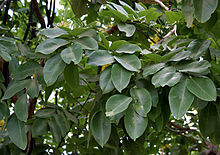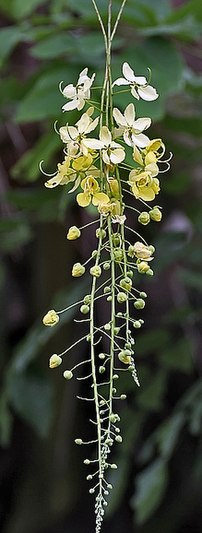Vanakam and blessed morning to all precious Atma,
Sacred Plant - Konrai or Cassia Fistula is for sale thru Artha Dharma.
Limited. First come first serve. Only in Malaysia.
SMS / Whats App to +60129259495
Email : sacredplants.artha@gmail.com
www.arthadharma.net
Cassia fistula, known as the golden shower tree and by other names, is a flowering plant in the family Fabaceae. The species is native to the Indian subcontinent and adjacent regions of Southeast Asia. It ranges from southern Pakistan eastward throughout Indiato Myanmar and Thailand and south to Sri Lanka. In literature, it is closely associated with the Mullai (forest) region of Sangam landscape. It is the national tree of Thailand, and its flower is Thailand's national flower. It is also the state flower of Kerala in India and of immense importance amongst the Malayali population. It is a popular ornamental plant and is also used in herbal medicine.
Contents
[hide]Description
The golden shower tree is a medium-sized tree, growing to 10–20 m (33–66 ft) tall with fast growth. The leaves are deciduous, 15–60 cm (5.9–23.6 in) long, and pinnate with three to eight pairs of leaflets, each leaflet 7–21 cm (2.8–8.3 in) long and 4–9 cm (1.6–3.5 in) broad. The flowers are produced in pendulous racemes 20–40 cm (7.9–15.7 in) long, each flower 4–7 cm (1.6–2.8 in) diameter with five yellow petals of equal size and shape. The fruit is a legume, 30–60 cm (12–24 in) long and 1.5–2.5 centimetres (0.59–0.98 in) broad, with a pungent odor and containing severalseeds. The tree has strong and very durable wood, and has been used to construct "Ahala Kanuwa", a place at Adams Peak, Sri Lanka, which is made of Cassia fistula (ahala, ehela, oraehaela, ඇහැල in Sinhala [2]) heartwood.
Cultivation
Cassia fistula is widely grown as an ornamental plant in tropical and subtropical areas. It blooms in late spring. Flowering is profuse, with trees being covered with yellow flowers, many times with almost no leaf being seen. It will grow well in dry climates. Growth for this tree is best in full sun on well-drained soil; it is relatively drought tolerant and slightly salt tolerant. It will tolerate light brief frost, but can get damaged if the cold persists. It can be subject to mildew or leaf spot, especially during the second half of the growing season. The tree will bloom better where there is pronounced difference between summer and winter temperatures.[3]
Pollinators and seed dispersal
Various species of bees and butterflies known to be pollinators of Cassia fistula flowers, especially carpenter bees (Xylocopa sp.).[4] In 1911, Robert Scott Troup conducted an experiment to determine how the seeds of C. fistula are dispersed. He found that golden jackalsfeed on the fruits and help in seed dispersal.[5]
Medical use
In Ayurvedic medicine, the golden shower tree is known as aragvadha, meaning "disease killer". The fruit pulp is considered apurgative,[6][7] and self-medication or any use without medical supervision is strongly advised against in Ayurvedic texts. Though its use inherbalism has been attested to for millennia, little research has been conducted in modern times.
Culture
The golden shower tree is the state flower of Kerala in India. The flowers are of ritual importance in the Vishu festival of Kerala, and the tree was depicted on a 20-rupees stamp. The golden shower tree is the national flower of Thailand; its yellow flowers symbolize Thai royalty. A 2006-2007 flower festival, the Royal Flora Ratchaphruek, was named after the tree, which is known in Thai as Ratchaphruek (Thai: ราชพฤกษ์) and the blossoms commonly referred to as dok khuen (Thai: ดอกคูน). C. fistula is also featured on a 2003 joint Canadian-Thai design for a 48-cent stamp, part of a series featuring national emblems.[3] Cassia acutifolia, the pudding-pipe tree, furnishes the cassia pods of commerce.[8]
Vernacular names
Being so conspicuous and widely planted, this tree has a number of common names. In English, it is also known as the golden shower cassia and also as Indian laburnum or golden shower. It is known in Spanish-speaking countries as caña fistula.
Names from its native range and surrounding regions include:[9]
- Arabic: khiār shambar (خيار شمبر)
- Assamese: xonaru (সোণাৰু)
- Bengali: sonalu (সোনালূু), sonal (সোনাল), bandar lathi (বাঁদরলাঠি বা বান্দর লাঠি), amaltas
- Burmese: ngu wah
- Chinese: ā bó lè (阿勃勒: Taiwan), là cháng shù (sausage tree, 腊肠树)
- Gujarati: garmalo (ગરમાળો)
- Hindi: amaltās (अमलतास), bendra lathi (or bandarlauri), dhanbaher (or dhanbohar), girimaloah
- Japanese: nanban saikachi (ナンバン サイカチ, Kanji: 南蛮皀莢)
- Khmer: reachapreuk (រាជព្រឹក្ស - rajavriksha / លឿងរាជ្យ / រាជ)
- Kannada: kakke (ಕಕ್ಕೆ ಮರ)
- Lao: khoun (ຄູນ)
- Marathi: bahava (बहावा)
- Malayalam: kanikkonna (or kani konna കണിക്കൊന്ന), Vishu konna(വിഷുക്കൊന്ന) also Ophirpponnu (ഓഫീർപ്പൊന്ന്) orKarnikaram (കർണ്ണികാരം) and Konnappoo (കൊന്നപ്പൂ).
- Meitei (Manipuri): chahui
- Nepali: amaltash, rajbriksya
- Oriya: sunari (ସୁନାରି)
- Sanskrit: aragvadha, chaturangula, kritamala, suvarnaka
- Sinhalese: aehaela, ඇහැල (or ahalla), ehela
- Tamil: konrai (கொன்றை)
- Telugu: raela (రేల)
- Thai: rachapruek (ราชพฤกษ์), khun (คูน), dok khuen (ดอกแคน)
The name was erroneously used by John Patrick Micklethwait Brenan for the Kenyan shower cassia, correctly known as C. afrofistula. Similarly, Francisco Manuel Blanco misapplied Linnaeus's name to the apple-blossom cassia C. javanica ssp. javanica.[10]
Serve above self,
Sivajnani Nagappan
+60129259495








No comments:
Post a Comment